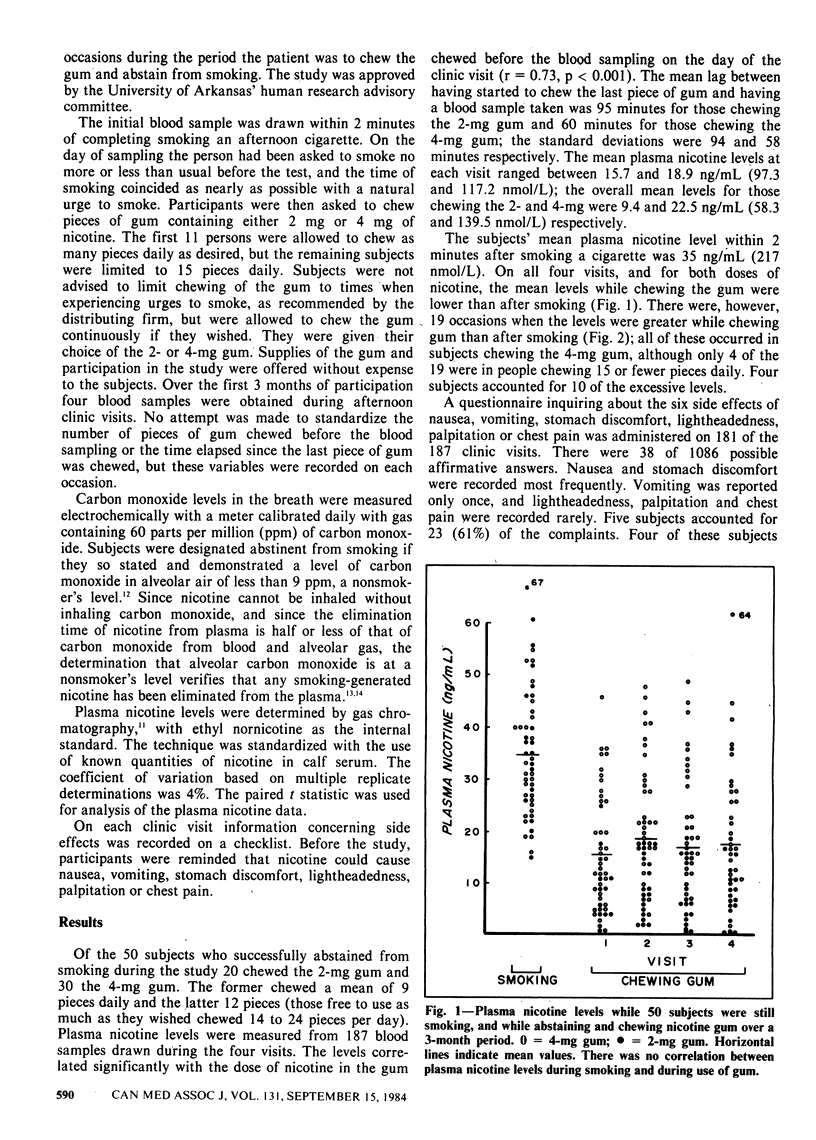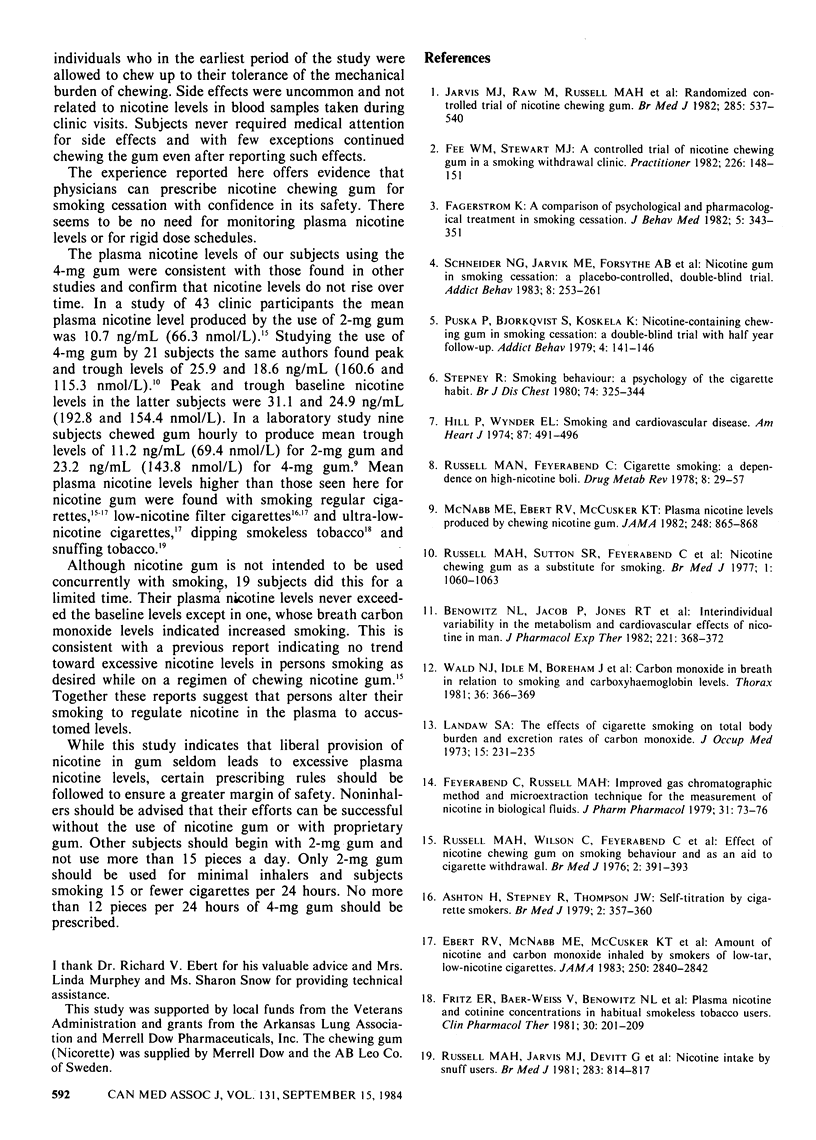Abstract
Techniques that help patients stop smoking should also reduce their exposure to agents such as nicotine. The mean plasma nicotine levels in 50 subjects while they were still smoking and then while they were chewing pieces of gum containing either 2 or 4 mg of nicotine over a 12-week period of abstinence were 35, 9 and 23 ng/mL (217, 56 and 143 nmol/L) respectively. A small number of subjects given an unlimited supply of gum used 14 to 24 pieces of 4-mg gum daily and had plasma nicotine levels exceeding the levels achieved while smoking. There were no acute symptoms necessitating medical intervention associated with these excessive levels. Side effects were uncommon and usually controllable. When simple dosage rules are followed people who chew nicotine gum for a few months to stop smoking lower their exposure to nicotine.
Full text
PDF



Selected References
These references are in PubMed. This may not be the complete list of references from this article.
- Ashton H., Stepney R., Thompson J. W. Self-titration by cigarette smokers. Br Med J. 1979 Aug 11;2(6186):357–360. doi: 10.1136/bmj.2.6186.357. [DOI] [PMC free article] [PubMed] [Google Scholar]
- Benowitz N. L., Jacob P., 3rd, Jones R. T., Rosenberg J. Interindividual variability in the metabolism and cardiovascular effects of nicotine in man. J Pharmacol Exp Ther. 1982 May;221(2):368–372. [PubMed] [Google Scholar]
- Ebert R. V., McNabb M. E., McCusker K. T., Snow S. L. Amount of nicotine and carbon monoxide inhaled by smokers of low-tar, low-nicotine cigarettes. JAMA. 1983 Nov 25;250(20):2840–2842. [PubMed] [Google Scholar]
- Fagerström K. O. A comparison of psychological and pharmacological treatment in smoking cessation. J Behav Med. 1982 Sep;5(3):343–351. doi: 10.1007/BF00846161. [DOI] [PubMed] [Google Scholar]
- Fee W. M., Stewart M. J. A controlled trial of nicotine chewing gum in a smoking withdrawal clinic. Practitioner. 1982 Jan;226(1363):148–151. [PubMed] [Google Scholar]
- Feyerabend C., Russell M. A. Improved gas chromatographic method and micro-extraction technique for the measurement of nicotine in biological fluids. J Pharm Pharmacol. 1979 Feb;31(2):73–76. doi: 10.1111/j.2042-7158.1979.tb13435.x. [DOI] [PubMed] [Google Scholar]
- Hill P., Wynder E. L. Smoking and cardiovascular disease. Effect of nicotine on the serum epinephrine and corticoids. Am Heart J. 1974 Apr;87(4):491–496. doi: 10.1016/0002-8703(74)90174-4. [DOI] [PubMed] [Google Scholar]
- Jarvis M. J., Raw M., Russell M. A., Feyerabend C. Randomised controlled trial of nicotine chewing-gum. Br Med J (Clin Res Ed) 1982 Aug 21;285(6341):537–540. doi: 10.1136/bmj.285.6341.537. [DOI] [PMC free article] [PubMed] [Google Scholar]
- Landaw S. A. The effects of cigarette smoking on total body burden and excretion rates of carbon monoxide. J Occup Med. 1973 Mar;15(3):231–235. [PubMed] [Google Scholar]
- McNabb M. E., Ebert R. V., McCusker K. Plasma nicotine levels produced by chewing nicotine gum. JAMA. 1982 Aug 20;248(7):865–868. [PubMed] [Google Scholar]
- Puska P., Bjorkqvist S., Koskela K. Nicotine-containing chewing gum in smoking cessation: a double blind trial with half year follow-up. Addict Behav. 1979;4(2):141–146. doi: 10.1016/0306-4603(79)90048-0. [DOI] [PubMed] [Google Scholar]
- Russell M. A., Feyerabend C. Cigarette smoking: a dependence on high-nicotine boli. Drug Metab Rev. 1978;8(1):29–57. doi: 10.3109/03602537808993776. [DOI] [PubMed] [Google Scholar]
- Russell M. A., Jarvis M. J., Devitt G., Feyerabend C. Nicotine intake by snuff users. Br Med J (Clin Res Ed) 1981 Sep 26;283(6295):814–817. doi: 10.1136/bmj.283.6295.814. [DOI] [PMC free article] [PubMed] [Google Scholar]
- Russell M. A., Sutton S. R., Feyerabend C., Cole P. V., Saloojee Y. Nicotine chewing gum as a substitute for smoking. Br Med J. 1977 Apr 23;1(6068):1060–1063. doi: 10.1136/bmj.1.6068.1060. [DOI] [PMC free article] [PubMed] [Google Scholar]
- Russell M. A., Wilson C., Feyerabend C., Cole P. V. Effect of nicotine chewing gum on smoking behaviour and as an aid to cigarette withdrawal. Br Med J. 1976 Aug 14;2(6032):391–393. doi: 10.1136/bmj.2.6032.391. [DOI] [PMC free article] [PubMed] [Google Scholar]
- Schneider N. G., Jarvik M. E., Forsythe A. B., Read L. L., Elliott M. L., Schweiger A. Nicotine gum in smoking cessation: a placebo-controlled, double-blind trial. Addict Behav. 1983;8(3):253–261. doi: 10.1016/0306-4603(83)90020-5. [DOI] [PubMed] [Google Scholar]
- Stepney R. Smoking behaviour: a psychology of the cigarette habit. Br J Dis Chest. 1980 Oct;74(4):325–344. [PubMed] [Google Scholar]
- Wald N. J., Idle M., Boreham J., Bailey A. Carbon monoxide in breath in relation to smoking and carboxyhaemoglobin levels. Thorax. 1981 May;36(5):366–369. doi: 10.1136/thx.36.5.366. [DOI] [PMC free article] [PubMed] [Google Scholar]


